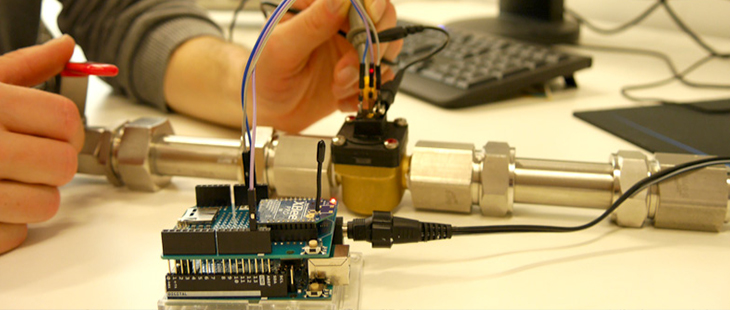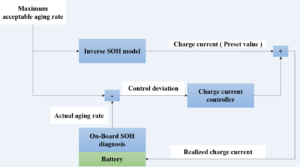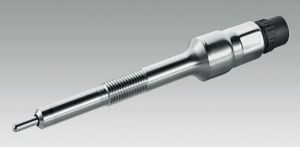
Current projects
Adaptive battery fast charging (ABSL)
The extensive conversion of individual transport from fuel-powered to battery electric vehicles (BEV), which is being pursued as part of the mobility transition, is particularly in Germany making only slow progress. Among the reasons for low acceptance of electric vehicles are their comparatively higher purchase costs with a shorter range, limited charging infrastructure and long charging times, which are perceived as inconveniences. With Li-ion cell prices already falling sharply and considerable progress in charging infrastructure possible, the issue of low range and long charging times is increasingly becoming a concern. In this context, the well-known significant reduction in battery life due to high charging power is of great importance, because short charging times can only be achieved by high charging power.
The established standard technology for BEVs is the lithium-ion accumulator (LIA). The voltage required in vehicles is typically several hundred volts, which is achieved by connecting a large number of individual cells in series. The capacity of each cell varies depending on manufacturing tolerances or different cell temperatures, for example, and overcharging and deep discharge can affect the cell negatively. Using a battery management system (BMS), the individual cells must be monitored and appropriate measures should be taken to maintain a consistent state of charge between each cell.
The core element of the combined control and precontrol of charge current for the cell is a diagnostic method to be developed. This method uses algorithms available in the BMS to determine the state of health (SOH) of the cell. If this aging progresses faster than defined by preset value, the charge current is reduced by charge current controller. Alternatively, if aging is slower than expected, the charge current is increased to speed up charging. Additionally, a feedforward control approach is also developed for reducing the load on the controller (inverse SOH model), which determines the maximum charging current based on the current boundary conditions (i.e. cell temperature, state of charge, etc.)
Project data

Basic idea of the process to be developed for gentle fast battery charging
- Project manager:
Prof. Dr. Josef Kainz/HSWT TUM Campus Straubing - Project consultant:
Jinghua Sun, M.Sc./HSWT TUM Campus Straubing - Project contributor external:
Dipl.-Ing. Markus Stutika/Vitesco Technologies GmbH - Project duration: 01.01.2021 – 31.12.2023
- Project partner: Vitesco Technologies GmbH
- Project management agency:
Bavarian State Ministry of Science and the Arts
Completed projects
Development of a micro-pump accumulator system with pump-as-turbine (PAT)
A successful continuation of the energy turnaround in the electricity sector with even higher proportions of renewable energies, whose feed-in is subject to weather-related, daily and seasonal fluctuations, will increase the demand for economically operable electricity storage facilities. Pumped storage technology is technically mature, but has so far only been used on a large scale for central plants.
The research project presented here is a cooperation project between the engineering office IB Pfeffer and the Department of Energy Technology of the Weihenstephan-Triesdorf University of Applied Sciences and focuses on the scaling of pumped storage technology to micro applications with outputs of less than 100 kW. The comparatively smaller environmental impacts, greater acceptance among the population and the possibility of making storage technologies accessible to smaller power generators are considered to be advantageous for smaller plants.
The following approaches are intended to counteract the increase in specific construction costs due to scaling:
To reduce the initial investment costs, standardised centrifugal pumps available on the market will be used. These not only permit pump operation, but can also be used as a turbine (pump as turbine – PAT) when the flow direction is reversed, with an achievable hydraulic efficiency of up to 80%.
The planning and project planning costs are to be reduced by a consistently pursued modular building block principle, both with regard to the mechanical components and the system control.
Necessary characteristic maps of the system components – primarily the complete characteristic maps of the centrifugal pumps – are determined in a hydraulic test bench designed for the project.
Project data
- Project manager: Prof. Dr. Josef Kainz/HSWT TUM Campus Straubing
- Project consultant: Florian Lugauer, M.Sc./HSWT TUM Campus Straubing
- Project duration: 01.01.2018 – 31.12.2021
- Project partner: IB P F E F F E E R – Engineering Office for Energy and Environmental Technology
- Project management agency: Bavarian State Ministry of Education and Cultural Affairs, Science and the Arts
- Funding programme: Programme for the promotion of applied research and development at universities for applied research and development in the field of applied sciences – Universities of Applied Sciences
Cylinder pressure based filling detection (ZyFüRe)

Series cylinder pressure sensors (Picture: ENT / TUMCS)
Driven by ever more restrictive legislation in the automotive sector, automobile manufacturers are increasingly willing to use high-performance sensors, which were previously only used for test bench tests, in series production as well. One example of such a sensor is the cylinder pressure sensor, which provides a better insight into the combustion process.
One of the first series cylinder pressure sensors is being developed by Continental. For research and development tasks, Continental and the Weihenstephan-Triesdorf University of Applied Sciences started a joint project in 2016. The goals of the project, which is headed by Prof. Dr. Josef Kainz, include reducing consumption and thus emissions, increasing efficiency and improving control under dynamic load conditions. These innovations are to be made possible by access to the energy release process in the combustion chamber and by sufficiently fast pressure detection in the cylinder. On this basis, characteristic process variables are calculated which can then be used to control the subsequent combustion. Control variables include ignition timing, injection, actuators such as the throttle valve or the exhaust gas recirculation valve. The main difficulty in this project is to determine the process variables under real operating conditions. For this purpose, measurements are carried out on the vehicle and on the engine test bench as well as simulations.
Project data
- Project manager: Prof. Dr. Josef Kainz/HSWT TUM Campus Straubing
- Project consultant: Dipl. Ing. (FH) Simon Härtl, M.Sc./HSWT TUM Campus Straubing
- Project duration: 01.03.2016 – 30.04.2019
- Project partner: Continental Automotive GmbH
- Project management agency: Continental Automotive GmbH

